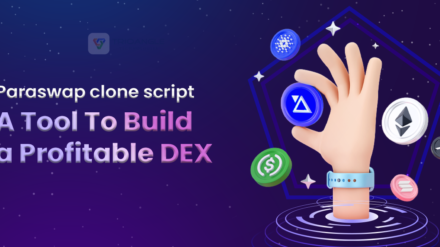Decentralized Finance (DeFi) is stepping up its benefits day by day. They have become a better alternative to our traditional financial system. From trading to lending and borrowing, DeFi helps users explore a diverse range of financial services without any centralized authority. However, it faces one major challenge: “liquidity”. Cross-chain communication solves this liquidity problem by connecting different blockchains and enabling them to move assets freely across them.
Let’s dive deeper and explore the role of cross-chain communication in enhancing DeFi liquidity on this blog.
Liquidity in DeFi: Why It’s Important?
Liquidity impacts how quickly and easily an asset can be traded on the platform without causing any significant change in its price. In our traditional market, financial institutions handle liquidity. But in DeFi, there is no central authority to manage these things. It uses decentralized exchange (DEX) liquidity pools to determine liquidity. If the pool has more liquidity, the transactions will be processed more easily on the platform.
However, the DeFi protocols run under various blockchain networks like Ethereum, Solana, and Binance Smart Chain (BSC). Each network traps assets on it, making it hard to use them effectively. This is known as “fragmented liquidity.” This fragmentation is seen as a primary obstacle to DeFi’s growth.
Here, cross-chain technology comes in to solve this fragmented liquidity issue.
How Cross-Chain Communication Solves Fragmented Liquidity
Cross-chain communication facilitates the interaction of various blockchain networks, allowing for asset transfers between them. This breaks the limitation of liquidity being stuck on one blockchain. As a result, traders can move their crypto assets to networks where they can achieve higher returns, while protocols benefit from larger liquidity pools.
Let me make this concept more understandable with a simple example.
Let’s say the user discovers that the Polygon offers a better return, but unfortunately, the user’s assets are on Ethereum. Here, the cross-chain technology helps them move their asset efficiently from Polygon to Ethereum without dependence on centralized exchanges.
Advantages Of Cross-Chain Liquidity
Cross-chain liquidity enhances DeFi protocols by addressing the issue of fragmented liquidity, leading to improved overall liquidity. This cross-chain technology makes DeFi more accessible and beneficial for users by connecting various blockchains to facilitate smoother crypto transfers. Let’s take a glimpse at the advantages of cross-chain liquidity.
1. Helps to Manage Capital More Efficiently
When liquidity isn’t struck on a single blockchain network, users can transfer their assets to the networks where they earn more attractive returns. For example, instead of leaving their crypto assets in the network where they gain a low yield, they can transfer them to the high-yield network. This way, users can manage their capital better.
2. Lower Slippage
Slippage refers to the situation where the trade price varies from your initial expectation. It happens when the protocol does not have enough liquidity. Cross-chain communication solves this issue and helps to improve the DeFi protocol’s liquidity by combining liquidity from various blockchains. This reduces the chances of price volatility while making larger trades, making transactions more stable and less expensive.
3. Risk Diversification
Cross-chain solutions let users spread their risks across various blockchain networks. Instead of putting their assets in a single network, they can allocate their funds to different ecosystems. This strategy helps to lower the risk associated with network-specific challenges, such as technical failures or regulatory obstacles.
4. Lowered Reliance on Centralized Exchanges
In the past, users were required to use centralized exchanges if they wanted to move their assets across different blockchains. Cross-chain communication enables direct transfer between users without depending on centralized platforms.
Right. Let’s see how cross-chain communication improves the DeFi liquidity now.
Cross-Chain Solutions Enhancing DeFi Liquidity
Different technologies are making it possible to achieve cross-chain liquidity. Let’s explore what they are.
Bridges
Platforms such as Stargate and Portal facilitate safer and more effective asset transfers between different blockchains by locking tokens on one chain and creating equivalent tokens on the target chain.
Liquidity Networks
With Thorchain and Chainlink’s Cross-Chain Interoperability Protocol (CCIP), users can make direct asset swaps between different blockchains without the need for wrapped assets.
Wrapped Tokens
Wrapped tokens like wrapped Ether (WETH) are tokens that originate from one blockchain but can operate on another. This feature supports cross-chain trading and improves liquidity.
Popular Cross-Chain Communication Protocol
Here are some popular platforms that use cross-chain communication effectively.
Polkadot
Polkadot is a platform that links multiple blockchains, known as parachains. So they can communicate and exchange data through their central hub, the relay chain.
Cosmos
Cosmos (IBC – Inter-Blockchain Communication) serves as a protocol that ensures secure interactions and asset transfers across the multiple blockchains in the Cosmos ecosystem.
Wanchain
Wanchain is a cross-chain platform specially designed to transfer assets and data in a more decentralized manner across various blockchain networks.
Axelar
Axelar is a decentralized cross-chain communication network that links different blockchains, making it easier to transfer assets securely.
Related Article: What Is Layer 2 Solutions In DEX and Its Advantages
Challenges in Cross-Chain Communication
Now that you know how cross-chain communication benefits the DeFi ecosystem by improving liquidity. Everything comes with its own pros and cons. You have come across the positive one, but now you need to explore its downside too. Next, we will examine the difficulties associated with cross-chain communication.
Security Challenges
Cross-chain protocols are among the primary targets for many hackers. These protocols have lost billions of dollars in the past. If you’re planning to build your own cross-chain platform, then it’s necessary to implement multi-signature authentication, and zero-knowledge proofs are essential.
Challenges in Standardization
Every blockchain operates with its own consensus mechanism and technical requirements. The technology to create a universal standard for communication across chains is not fully built, it’s still in progress.
Centralization Challenges
Some cross-chain solutions depend on centralized validators, which reduces the level of decentralization. Although more decentralized alternatives are being developed, they still need more development.
That’s it! We’ve reached the conclusion of our topic on “The Role of Cross-Chain Communication in Enhancing DeFi Liquidity.
So, let’s wrap up!
Wrapping Up
Cross-chain communication plays a vital role in improving the DeFi protocol’s liquidity. It helps to eliminate liquidity fragmentation and facilitates smoother asset transfer across multiple networks. Moreover, it reduces slippage and improves capital management.
In summary, cross-chain communication benefits both platform owners and traders.
If you’re an aspiring entrepreneur looking to create DeFi solutions with cross-chain features, Trioangle is here to make this possible. As a top-tier DeFi development company, we help you every step of establishing your crypto business. Contact us today and get started.








